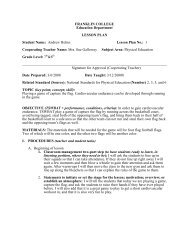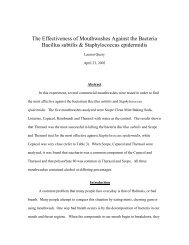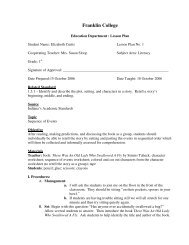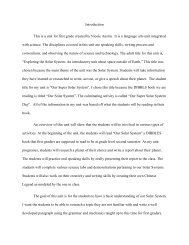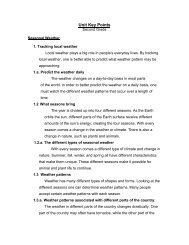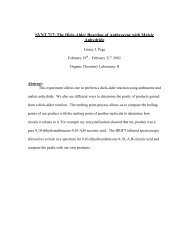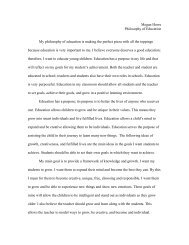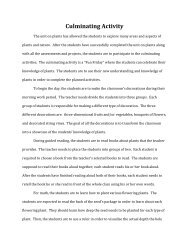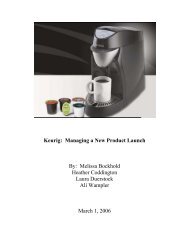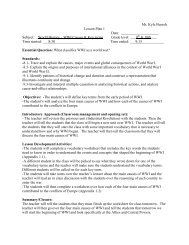Nitrating Methyl Benzoate: Electrophilic Aromatic ... - Franklin College
Nitrating Methyl Benzoate: Electrophilic Aromatic ... - Franklin College
Nitrating Methyl Benzoate: Electrophilic Aromatic ... - Franklin College
You also want an ePaper? Increase the reach of your titles
YUMPU automatically turns print PDFs into web optimized ePapers that Google loves.
<strong>Nitrating</strong> <strong>Methyl</strong> <strong>Benzoate</strong>: <strong>Electrophilic</strong> <strong>Aromatic</strong> Substitution<br />
Part 5 – Melting Points and Infrared Spectrum<br />
Prepare a melting point capillary of the recrystallized product and take its melting point. Also, perform an infrared<br />
spectrum on the recrystallized product. Do this by adding 100 mg KBR to approximately 1mg of the recrystallized<br />
product. Mix the two using a mortar and pestle, being sure to grind the two compounds into a fine powder. Place some<br />
of this mixture in a microcup, making sure the surface is smooth. Then place the pellet in the infrared spectrometer<br />
and obtain an infrared spectrum of the product.<br />
Part 5 – Clean Up<br />
Place all waste materials in their appropriate waste containers.<br />
Data and Calculations:<br />
Mass methyl benzoate used: 0.554 g<br />
Mass recrystallized crystals: 0.413 g<br />
Percent Yield: 56.42%<br />
Melting Point recrystallized product: 77.5 - 80°C<br />
Literature Value: 78 - 80°C<br />
Finding Limiting Reagent<br />
HNO3 (0.5 mL HNO3) (1.5027 g HNO3) (1 mol HNO3) (1 mol methyl nitrobenzoate) (181.3 g methyl nitrobenzoate)<br />
(1 mL HNO3) (63.01 g HNO3) (1 mol HNO3) (1 mol methyl nitrobenzoate)<br />
= 2.159 g methyl nitrobenzoate<br />
H2SO4 (0.6 mL H2SO4) (1.841 g H2SO4) (1 mol H2SO4) (1 mol methyl nitrobenzoate) (181.3 g methyl nitrobenzoate)<br />
(1 mL H2SO4) (98.08 g H2SO4) (1 mol H2SO4) (1 mol methyl nitrobenzoate)<br />
= 2.039 g methyl nitrobenzoate<br />
<strong>Methyl</strong> <strong>Benzoate</strong> (0.554 g methyl benzoate) (1 mol methyl benzoate) (1 mol methyl nitrobenzoate) (181.13 g methyl nitrobenzoate)<br />
(136.15 g methyl benzoate) (1 mol methyl benzoate) (1 mol methyl nitrobenzoate)<br />
= 0.732 g methyl nitrobenzoate<br />
The limiting reagent for this electrophilic aromatic substitution reaction is methyl benzoate. It yields the least amount of<br />
methyl nitrobenzoate in this reaction, and therefore is the limiting reagent.<br />
Theoretical Yield<br />
(0.554 g methyl benzoate) (1 mol methyl benzoate) (1 mol methyl nitrobenzoate) (181.13 g methyl nitrobenzoate)<br />
(136.15 g methyl benzoate) (1 mol methyl benzoate) (1 mol methyl nitrobenzoate)<br />
= 0.732 g methyl nitrobenzoate<br />
Percent Yield<br />
For recrystallized product (mass of recrystallized methyl nitrobenzoate) (0.413 g methyl nitrobenzoate) x (100) =<br />
(theoretical yield) (0.732 g methyl nitrobenzoate)<br />
=56.42% yield




